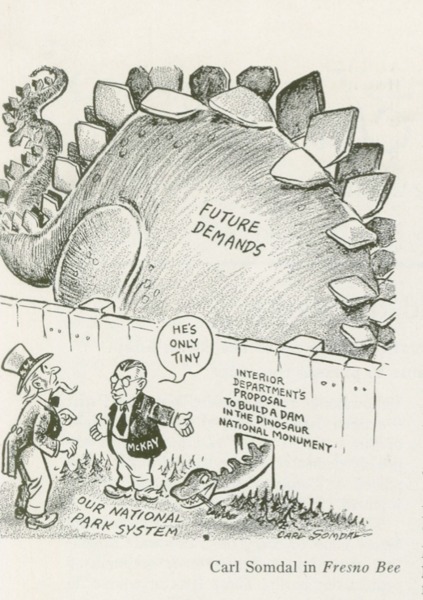Dublin Core
Title
Description
Echo Park sits at the confluence of the Green and Yampa Rivers, nestled under the sandstone cliffs of Dinosaur National Monument. In 1953, the US Bureau of Reclamation recommended this remote canyon as the site for a dam, one of several proposed for its Colorado River Storage Project. The plan sparked a major battle between demand for water and desire for preservation, and Echo Park became a rallying cry for the conservation movement.
The idea to build dams along the Green River was not new, but the post-World War II population boom created a demand for water and hydro-power that could not be ignored. The Secretary of the Interior supported the Echo Park plan, citing the area’s narrow canyons as ideal for a dam and reservoir. But the proposal – which would alter the landscape of a designated National Monument – alarmed the National Park Service. Conservation groups agreed, and saw the Bureau of Reclamation plan as a deliberate threat to America’s public lands.
The Echo Park controversy became national news. Writers and journalists weighed in, and public outcry against the dam was fierce. Leading the opposition was the Council of Conservationists, a coalition of nine groups who mobilized their members to defend Dinosaur National Monument and the Park System as a whole. This was the first time they had worked together to defeat a plan of such magnitude. It was helpful to their cause that travel to national parks had risen sharply through the postwar years and that well-known groups – such as the Audubon Society and the Sierra Club – publicly fought components of the project.
Thanks to this grassroots campaign, the Echo Park dam was never built, and in 1956 Congress prevented the development of dams in national parks or monuments. But the victory was bittersweet. Sierra Club Director David Brower always regretted the trade-off they made to stop the dam at Echo Park, which was to let the dam at Glen Canyon proceed unopposed. This compromise demonstrates both the power and limitations of environmentalism, a movement that continues to impact policy in the increasingly arid and thirsty West.
Creator
Source
_______________
See Brandon Loomis, “The Dam Not Built: Echo Park at Dinosaur National Monument,” AZ Central, October 14, 2013; David Kent Sproul, “Environmentalism and the Kaiparowits Power Project, 1964-1976,” Utah Historical Quarterly 70, no. 4 (2002): 356-71; Debra Elaine Jenson, “Dinosaur Dammed: An Analysis of the Fight to Defeat Echo Park Dam” (PhD diss., University of Utah, 2014); George Mumford, Northern Arizona University, “Echo Park Dam and the Early Environmental Movement,” Intermountain Histories, accessed April 29, 2021; Glenn Sandiford, “Bernard DeVoto and His Forgotten Contribution to Echo Park,” Utah Historical Quarterly 59, no. 1 (1991): 72-86; John Upton Terrell, War for the Colorado River, Volume II (n.p.: The Arthur H. Clark Company, 1966): 85-90; Mark Harvey, "Echo Park Dam Controversy," Colorado Encyclopedia, last modified May 04, 2020.

